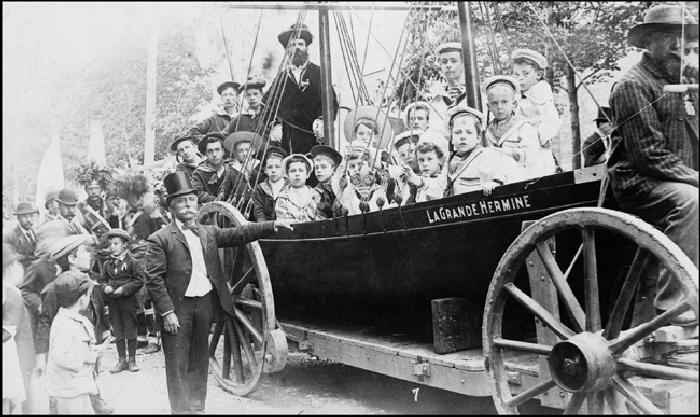
Quebec Provincial Holiday: Feast of St. John the Baptist

Figure 1.-- We notice the Feast of St John the Baptist is a big event in Montreal. We have few details at this time. Hopefully our Canadian readers will be able to provide some details. We note the celebration in 1895. One of the floats is a boat, "La Grande Hermine" filled wih boys. All the boys in the boat wear sailor suits with sailor caps.
|
|
We thought at first that this was a religious celebration. A Canadian reader tells us that it is more of a patriotic/cultural celebration for Quebecers and other French Canadians. Explorers like Cartier and Champlain are honored. The celebration is named after St. John the Baptist who was the patron saint of New France (Camada). This reflects the former importance of the Catholic Church in French Canada. John the Baptist of course had no real connection with French Canada except that he was chosen the patron saint.
John the Baptist
We notice the Feast of St John the Baptist celebration is a major event in Montreal. John the Baptist is of course the precursor who baptized Jesus. He is the patrion saint of French Canada. His Feast day corresponds to the summer equinox. At the parade, the last car
depicts St John the Bastist as a child with sheep. Ordinarily,
the boy had a sheep skin and his hair were curly. It was the symbol of
the "model" child. It is certainely a custom from Normandy. In the province of Québec, the June 24 is a state holiday like July 1 is the rest of Canada--the Federal holiday of Confederation.
1895 Celebration
Here we see the St. John the Baptist celebration in 1895 (figure 1). One of the floats is a boat, La Grande Hermine filled wih boys. This has nothing to do with John the Baptist, but the festival appers to be a partiotic celebration of Quebec history. All the boys in the boat wear sailor suits with sailor caps.
La Grande Hermine was one of the three ships used in 1534 by Jacques
Cartier, the discoverer of Canada. The other two were La Petite Hermine
and l'Èmérillon. Hermine is the fur of the ermine, a very valuable fur used on the shoulders for capes worn by Kings and Queens. The major economic enterprise in French Canada was the extremely valuable fur trade. Emerillon is a bird used for hunting.
French Canadian Celebration
A Canadian reader tells us, "The catholic celebration of the St Patron
of French Canadians is celebrated June 24 which is also the national feast of Quebec. There was in the streets of Montreal (Sherbrooke street from University to
Parc lafontaine) a big parade with vintage cars cars on a different theme
each year. The parade continues today only at night. I suspect that OUR HISTORY
was the main theme of the celebrations that year with Jacques Cartier,
this navigator from St-Malo, France who crossed the Atlantic from France and
discovered the St. Lawrence River. He landed at Gaspé where he set a cross
in the name of King Francis I. From 1534 until 1763, Canada called Nouvelle France was the exclusive property of the kings of France. Because there were the Wars of religion in France between protestants (Huguenots) and Catholics for around 50 years, the next landing of French was in 1608 under the auspices of King Henri IV. Samuel de Champlain was an outstanding geographer. He explored the St. Lawrence
River as far as the Great Lakes and also the south to Lake Champlain in Vermont which is on the United States-Canadian border. Champlain founded Quebec City (1608). He was the first Governor of Nouvelle France and the first settlers established down the Cap Diamant. It was the first permanent French establishment in North America, about the same time as Jamestown (1607) but before the Pilgrims in Massachusetts (1620).
Quebec
We thought at first that this was a religious celebration. A Canadian reader tells us that it is more of a French Canadian patriotic/cultural celebration. He writes, "I would not describe the Feast of St. John the Baptist as a religious event. What is
appropriate is this: Québec National Celebration: St-John-the-Baptist.
The saint is there mainly because it happens that his feast is on the
24th of June since Medieval times. It is essentially a state celebration without any connatations on today with religion. For sure, it was more related to religion in the 19th and the first part of the 20th centuries. But themes chosen were more on social changes in regard with traditions than a religious fest like the Fête-Dieu in in beginning of June. On today, for respect with other denominations, there are no processions in the streets for any religious celebrations. Never forget that Quebecers or French-canadians as you say are perceiving as a people and as such their have their own civilian laws from Code Napoleon instead of the British common law. Also, Health and Education are 100 percent from provincial jurisdiction.
Canada is a confederation of ten states, not a unified country like
France. It is bilinguial in its federative aspects but Qubec is
unilingual like New brunswick is bilinguial and the remaining eight are
unilinguial English. There are more protection for the English minority
in Québec than protection for the million of French-Canadian in
Ontario. There is nothing racist in saying this. Those are facts, nothing more." A lot of Quebecers feel at ease with the constitution
HBC

Navigate the Boys' Historical Clothing Web Site:
[Return to the Main Canadian religion page]
[Return to the Main Canadian activities page]
[Return to the Main sports page]
[Introduction]
[Activities]
[Biographies]
[Chronology]
[Clothing styles]
[Countries]
[Bibliographies]
[Contributions]
[FAQ]
[Glossaries]
[Satellite sites]
[Tools]
[Boys' Clothing Home]
Created: 10:59 PM 2/18/2006
Last updated: 6:34 PM 2/21/2006



